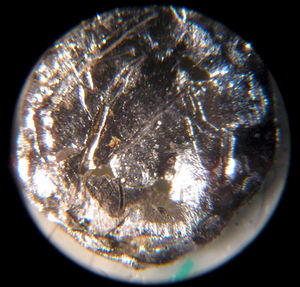Difference between revisions of "Americium"
(Added picture, added group and series, fixed a spelling mistake.) |
|||
| Line 2: | Line 2: | ||
{{Infobox element | {{Infobox element | ||
<!-- top --> | <!-- top --> | ||
| − | |image name= | + | |image name= Americium_microscope.jpg |
|image alt= | |image alt= | ||
|image size= | |image size= | ||
| − | |image name comment= | + | |image name comment= A small disc of americium under a microscope.<br><br>[https://commons.wikimedia.org/wiki/User:Bionerd Bionerd], [https://commons.wikimedia.org/wiki/File:Americium_microscope.jpg Americium microscope], [https://creativecommons.org/licenses/by/3.0/legalcode CC BY 3.0] |
|image name 2= | |image name 2= | ||
|image alt 2= | |image alt 2= | ||
| Line 33: | Line 33: | ||
|series= | |series= | ||
|series ref= | |series ref= | ||
| − | |series comment= | + | |series comment=[[Actinides]] |
|series color= | |series color= | ||
|group= | |group= | ||
|group ref= | |group ref= | ||
| − | |group comment= | + | |group comment=n/a |
|period=7 | |period=7 | ||
|period ref= | |period ref= | ||
| Line 290: | Line 290: | ||
*Make your own personalized smoke detector | *Make your own personalized smoke detector | ||
*Neutron source | *Neutron source | ||
| − | *Make a | + | *Make a spectrometer |
==Handling== | ==Handling== | ||
Revision as of 23:25, 5 September 2020
 |
This article is a stub. Please help Sciencemadness Wiki by expanding it, adding pictures, and improving existing text.
|
 | |||||
| General properties | |||||
|---|---|---|---|---|---|
| Name, symbol | Americium, Am | ||||
| Appearance | Silvery-gray | ||||
| Americium in the periodic table | |||||
| |||||
| Atomic number | 95 | ||||
| Standard atomic weight (Ar) | 243 | ||||
| Element category | Actinides | ||||
| Group, block | n/a; f-block | ||||
| Period | period 7 | ||||
| Electron configuration | [Rn] 5f7 7s2 | ||||
per shell | 2, 8, 18, 32, 25, 8, 2 | ||||
| Physical properties | |||||
| Silvery-grey | |||||
| Phase | Solid | ||||
| Melting point | 1449 K (1176 °C, 2149 °F) | ||||
| Density near r.t. | 12 g/cm3 | ||||
| Heat of fusion | 14.39 kJ/mol | ||||
| Molar heat capacity | 62.7 J/(mol·K) | ||||
| pressure | |||||
| Atomic properties | |||||
| Oxidation states | 8, 7, 6, 5, 4, 3, 2 (an amphoteric oxide) | ||||
| Electronegativity | Pauling scale: 1.3 | ||||
| energies | 1st: 578 kJ/mol | ||||
| Atomic radius | empirical: 173 pm | ||||
| Covalent radius | 180±6 pm | ||||
| Miscellanea | |||||
| Crystal structure | Double hexagonal close-packed (dhcp) | ||||
| Thermal conductivity | 10 W/(m·K) | ||||
| Electrical resistivity | 0.69 Ω·m | ||||
| Magnetic ordering | Paramagnetic | ||||
| CAS Registry Number | 7440-35-9 | ||||
| History | |||||
| Naming | After the Americas | ||||
| Discovery | Glenn T. Seaborg, Ralph A. James, Leon O. Morgan, Albert Ghiorso (1944) | ||||
Americium is a radioactive chemical element, a transuranic member of the actinide series, with symbol Am and atomic number 95. The most important isotope of this element is Americium-241 (241Am).
Contents
Properties
Chemical
Like all actinides, americium reacts with air and halogens at standard conditions.
Physical
Americium is a silvery-gray metal, with a density of 12 g/cm3 at room temperature. It melts at 1176 °C and boils at 2607 °C.
Availability
Americium is readily found in smoke detectors, in the form of americium dioxide aggregate deposited on a small Al button, which is the ionization source for the smoke detector. Each radioactive button contains around 0.26 micrograms of 241Am. To obtain a significant amount of Am, you will need dozens (minimum) of Am buttons. However, acquiring lots of smoke detectors may draw the attention of the authorities.
Isolation
Isolation of this element is difficult to do given the low concentration of Am in smoke detectors and its high reactivity.
Projects
- Make your own personalized smoke detector
- Neutron source
- Make a spectrometer
Handling
Safety
Americium, like all actinides, is radioactive and very toxic, but the amounts encountered in smoke detector buttons are too small to pose any appreciable hazard.
Storage
Americium should be kept in thick vials, lead is also good for shielding.
Disposal
Americium should be taken to centers that take care of used smoke detectors.